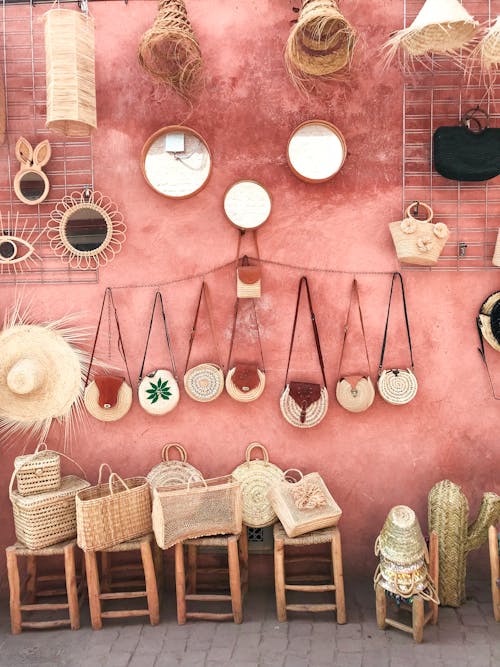Top 10 Made in India products that small businesses can easily source across the world!

India is a popular sourcing hub supplying products to online & offline retailers across the world. Many advantages of sourcing from India include quality products, better prices, and sustainable practices throughout the value chain. India offers a wide variety and range of products which are a reflection of its socio-cultural diversity. Most of these have an inherent uniqueness and are not available anywhere in the world.
- Regional handicraft products:
India is deeply rooted in its socio-cultural heritage and has a diverse range that is reflected in the regional handicrafts unique to the region’s culture. The centuries-old artisanal manufacturing methods are traditionally embedded with sustainability and an eco-conscious approach. They offer a legacy of the quintessential Indian culture encompassing beauty, dignity, form, and style. These products have high demand in international markets, primarily the U.S.A. and Europe. They can often be seen being sold in international trade fairs or offered on online portals.
Around 6 million artisans across the country are engaged in the Indian handicrafts sector. Most of these skilled and unskilled workers are either women or from weaker sections of society. The accelerating demand across geographies and borders has resulted in more work and higher income for these traditional artisans. The industry itself is very decentralized in the country. The following places are quite popular for their unique crafts and styles.
Art Metalware: Moradabad, Sambhal, Aligarh, Jodhpur, Jaipur, Delhi, Rewari, Thanjavur, Chennai, Mandap, Beedar, Kerala, Jagadhari, and Jaisalmer
Wooden Artwares: Saharanpur, Nagina, Hoshiarpur, Srinagar, Amritsar, Jaipur, Jodhpur, Jagdalpur, Bengaluru, Mysore, Chennapatna, Chennai Kerala & Behrampur (WB)
Hand Printed Textiles and Scarves: Amroha, Jodhpur, Jaipur, Farrukhabad, Sagru & Sanganer
Embroidered Goods: Kutch, Jaisalmer, Baroda, Lucknow, Jodhpur, Agra, Amritsar, Kullu, Dharamshala, Chamba & Srinagar
Marble & Stone Craft: Agra, Chennai, Bastar, and Jodhpur
Terracotta: Agra, Chennai, Bastar, and Jodhpur
Zari & Zari Goods: Rajasthan, Chennai, and Bastar
Paper Machine Craft: Kashmir, Jaipur
Artistic Leather Goods: Indore, Kolhapur and Shanti Niketan (WB)
Imitation Jewelry: Delhi, Moradabad, Sambhal, Jaipur, and Kohima (for tribal motifs)

2. Agricultural products:
India’s climatic conditions & geographical location make it favourable for a wide variety of seasonal fruits, vegetables, and grains. Organica products have higher demand in international markets. Let’s look at some of the most popular agricultural products of India.
Basmati Rice and Non-Basmati Rice: India is the second-largest producer of rice in the world contributing to 25% of international trade of rice & states that contribute the most are: Punjab, Odisha, Assam, West Bengal, Uttar Pradesh
Fresh fruits and vegetables: India is the largest producer of bananas, papayas, and mangoes. Mango is the king of fruits in India. The different varieties of mango including Alphonso, Hapus, Badami, Chausa, and Dasheri are loved all over the world. India is also one of the largest producers of vegetables like okra, ginger, potatoes, onions, cabbages, and tomatoes.
India is also the second-largest producer of wheat and exports large quantities. It is also known for its export quality output for a range of agricultural products and processed food. Some notable ones are groundnut, processed fruits & juices, cereal & cereal preparations, guar gum, alcoholic beverages, processed vegetables, pulses, cocoa products, sheep and goat meat, milled products, floriculture, poultry products, fruits & vegetable seeds, animal casings, and processed meat.

3. Precious stones, gems, and jewellery
India has a centuries-old rich culture of production and consumption of precious stones, gems, and jewellery. Recently, the international market has shown great interest in the Indian jewellery art and design and precious stones market.
In spite of not being home to the huge diamond mines, India has the world’s largest industry of cutting raw diamonds Despite not being home to vast diamond mines, India has the world’s largest industry for cutting raw diamonds and diamond polishing. Surat is the world’s largest processor of raw diamonds converting them into beautiful pieces of sparkling diamonds. The diamond cutting & polishing industry has strong support from the government. Financial institutions have invested in the sector with around 50 banks backing it with a credit to the tune of ~US$3 billion.

4. Textile products
Just like the rich cultural diversity of India, India presents a bouquet of key textile hubs to the world which are popular Just like the rich cultural diversity of India, India presents a bouquet of key textile hubs to the world which are known for their material and craftsmanship. Over 70 clusters in the country contribute about 85% of the total textiles manufactured.
North: Panipat accounts for up to 75% of the total blankets and quilts manufactured, and together with Kashmir and Ludhiana, it produces 80% of the woollen textiles in India. Ludhiana contributes almost 95% in the manufacturing of woollen knitwear.
East: The industry is less uniform and much more diverse compared to the other parts of India. Bihar is famous for its jute industry, Uttar Pradesh for its woollen items, and Bengal is known for its cotton and jute sectors.
South: South is the core centre for hosiery or knit apparel. The three cities of Tirupur, Coimbatore, and Madurai combinedly producing and exporting around 80% of the total hosiery in the country. Bengaluru, Mysore, and Chennai churn out the majority of silk produced in the country.
West: The textile industry of Surat is one of the oldest, with a significant amount of local population engaged in the same. Surat is also the largest centre for man-made fibre (MMF) in India. The daily production of raw fabric is estimated to be over 30 million metres and 25 million metres for processed fabric.
Ahmedabad, Indore, Mumbai, Rajkot, and Vadodara are key cotton producers in India.

5. Leather and leather products
Indian leather industry accounts for around 12.9% of the world’s leather production of leather raw materials (hides/skins) & contributes about 3 Bn sq. ft. of leather every year. 9% of the world’s footwear production is contributed by India. Indian leather & finished products are very popular in international markets i.e. U.S, Germany, France, etc. India is the 2nd largest producer of leather footwear & garments in the world. India is also the 5th largest exporter of leather goods & accessories in the world.
Tamil Nadu – Chennai, Ambur, Ranipet, Vaniyambadi, Vellore, Pernambut, Trichy, Dindigul and Erode;
West Bengal – Kolkata;
Uttar Pradesh – Kanpur, Agra, Noida, Saharanpur;
Maharashtra – Mumbai;
Punjab – Jalandhar;
Karnataka – Bengaluru; Telangana Hyderabad;
Haryana – Ambala, Gurugram, Panchkula, Karnal, and Faridabad; Delhi;
Madhya Pradesh – Dewas;
Kerala – Kozhikode, Ernakulam, andCochin;
Rajasthan – Jaipur; Jammu & Kashmir – Srinagar.

6. Organic supplements and medicines
With the rising popularity of Yoga & Ayurveda in western countries, demand for herbal medicines, tea, and organic supplements has significantly increased. Some of the prime organic products are original harvested honey, herbs & herbal supplements, organic fertilizers, organic fruits & vegetables, organic juices & processed foods.

7. Meat products
India is the world’s 5th largest export of meat & meat products, contributing to ~7% of the world’s meat trade. India is a leading exporter of buffalo meat. It also supplies pork in large quantities. Countries that are land-locked and do not have sea access import seafood from India. Lobster & shrimp sourced from India are very popular in the international market.

8. Dairy products:
With the implementation of the white revolution in the 1970s, India became the biggest producer of milk in the world. The dairy industry engages around 80 million rural Indian households in milk production. It is the largest single agricultural commodity with ~4% share in the Indian economy. The sector also has other products like processed milk products, protein supplements, health foods, yoghurt, and ice creams.

9. Coffee, tea, & other spices:
Indian teas are world-famous. Darjeeling tea from Bengal is considered to be one of the best black teas in the world due to its top-rated quality and special aroma. Assam tea, the staple tea in breakfast blends worldwide, is well known for its bold taste and robust flavour. Other main tea regions of India are Nilgiri, Coonoor, Dooars, Sikkim, Terai, Himachal Pradesh, Travancore, and Kerala.
India is the 3rd-largest producer & exporter of coffee in Asia & the 6th largest exporter. Karnataka, Kerala, and Tamil Nadu are the biggest producers of export quality coffee in the country.
Indian spices are also in great demand in European countries. Red chilly is the most sought-after spice followed by cumin and turmeric.

10. Petroleum products
Large companies dominate the landscape of petroleum exports. However, small businesses are now investing heavily in semi-products of petroleum such as pet coke, wax, charcoal, and coal. These products are in huge demand by small developing countries like Bhutan, Bangladesh, Nepal, and Myanmar, which do not have manufacturing capabilities.

The range of products a business can source from India is unparalleled. The distinctive features and remarkable artistry of the country add considerable value to the final merchandise. India-based products are the cornerstone of many successful businesses in the international markets.
With the rise in e-commerce businesses, there is also a growing demand for reliable online cross-border sourcing platforms. Tradyl is here to cater to all your business needs and decisions related to sourcing from India.
If you are a brand or retailer, wherever you may be located, add India’s diverse products to the selection you offer to your customers, they are sure to love it! Start exploring some ready-to-ship products from India right here.


